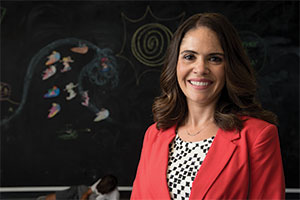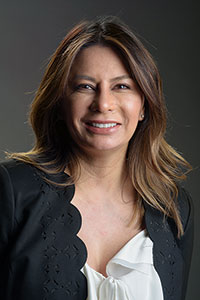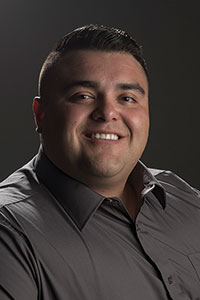Executive Decisions
A pioneer in behavioral therapy spearheads a new psychology program focused on treating autism spectrum disorders
 Life is all about human interaction: calling your parents to ask how they’re doing,
texting your friends to make weekend plans, stopping by your coworker’s cubicle to
see if that report is ready. These everyday social scenarios involve communication,
cooperation, and compromise—all crucial skills that allow us to think critically and
live independently.
Life is all about human interaction: calling your parents to ask how they’re doing,
texting your friends to make weekend plans, stopping by your coworker’s cubicle to
see if that report is ready. These everyday social scenarios involve communication,
cooperation, and compromise—all crucial skills that allow us to think critically and
live independently.
But these skills, which must be taught and practiced during childhood to help navigate us through adulthood, are sometimes difficult to instill—especially in individuals diagnosed with disorders such as autism spectrum disorder (ASD) and attention deficit disorder. Training these individuals to boost their interaction skills is the specialty of board certified behavior analysts (BCBAs), a dedicated group of therapists with particular expertise in applied behavior analysis (ABA). Generally speaking, ABA methods are used to improve behavioral excesses (to reduce actions that are expressed too frequently) as well as behavioral deficits (to increase engagement in certain activities).
As a nationally recognized leader in the field of ABA, Associate Professor Adel Najdowski directs the new master of science in behavioral psychology program at the Graduate School of Education and Psychology, where students receive hands-on training working directly with children and adults diagnosed with ASD. Through her courses, the esteemed psychologist imparts her vast knowledge of ABA intervention to effectively promote emotional self- regulation and self-management skills within this specific population.
 School Daze
School Daze
Through courses like Autism Spectrum Disorders, Najdowski informs her students about some of the most frequent experiences that young children encounter at school prior to becoming officially diagnosed with ASD or attention deficits.
According to Najdowski, children’s issues with self-management and self-awareness are commonly misconceived by schoolteachers, who oftentimes mistake exhibitions of these behavioral deficits as acts of disobedience or noncompliance. This is especially true when teachers have just finished reviewing the details of an upcoming assignment in class and students with these diagnoses do not know how to get started on a project that was discussed just moments earlier.
“They get overwhelmed, so we must teach them how to break down these tasks into smaller units and also how to plan each step,” she explains.
Many children with ASD also tend to avoid eye contact due to their interest in objects more than faces and sometimes dominate conversations and talk only about their own interests. When communicating with these individuals, Najdowski emphasizes the importance of attributing some of their behaviors not to impoliteness or inconsideration, but to their executive dysfunction—a hindrance in the mental processes that help individuals self- manage their time, energy, and resources in order to accomplish goals like daily household chores.
“Oftentimes, they do not have the skills to understand that what they are thinking and experiencing is different than what other people are thinking and experiencing,” she explains. “It looks like they lack empathy, but it’s really a skill deficit.”
Open to Negotiation
 Currently enrolled in the pilot program, graduate student Stacey Coombes became completely
fascinated with ABA interventions when she first became a behavior therapist and began
teaching these skills to clients diagnosed with ASD and watching them connect with
their caregivers.
Currently enrolled in the pilot program, graduate student Stacey Coombes became completely
fascinated with ABA interventions when she first became a behavior therapist and began
teaching these skills to clients diagnosed with ASD and watching them connect with
their caregivers.
Under Najdowski’s mentorship, she is in the process of exploring ABA outside the classroom as she writes her thesis on social problem-solving—a behavioral process she describes as “the ways in which people negotiate getting what they want in everyday life.” As Coombes explains, developing social problem-solving skills begins with identifying a problem during a social interaction and creating a solution for the best possible result. In sharpening these skills, individuals will cultivate a range of behaviors that can produce a desired effect.
“Social problem-solving is not an inherent trait,” the behavior therapist contends, adding that deciding how to act in an effort to get what we want requires several simultaneous social behaviors, including identifying a problem (both from our own perspective and the perspective of others involved) and selecting the best possible solution for resolving the problem.
To clarify this concept, she points to the familiar family- friendly activity of playing board games, noting that while determining who should start the game off might seem like a simple decision, it actually involves a complex thought process for the players.
In order to collect the appropriate data for her thesis, Coombes is working with Najdowski to teach social problem-solving skills to several young participants.
“Children diagnosed with ASD generally have deficits in the area of social interactions and perspective taking. Teaching them effective skills allows them to communicate their wants and needs with other people, which further engages them socially,” Coombes says.
In the Interest of Time
 Graduate student Jesse Fullen, who has long been fascinated by the connection between
the physical and social components of human behavior, is also applying ABA approaches
to train his young clients.
Graduate student Jesse Fullen, who has long been fascinated by the connection between
the physical and social components of human behavior, is also applying ABA approaches
to train his young clients.
Fullen’s investment in becoming a BCBA is trifold, as he divides his time between taking courses in the master’s program, working as a behavior therapist for an ASD agency, and assisting Najdowski with her field research, including a research project focused on teaching time management skills to children diagnosed with autism.
“Children with autism don’t realize that they are against the clock,” he reveals. “They come into these situations where they either overbook themselves or run out of time to complete a certain activity.”
In an effort to help improve these deficits, Fullen is assisting Najdowski in a research project she is conducting with a local ASD agency, The ABRITE Organization, located in Sherman Oaks, California. Fullen is working directly with ABRITE’s clinical manager Fernanda Welsh to gather research data corresponding to an intervention for teaching children what a schedule is and how to follow one, as well as how to manage their time by determining how much time is left for finishing a specific task.
Fullen’s current commitments to the field have proven both strategic and fruitful, as all three facets of his academic and professional experience have invoked in him a passion for creating his own curriculum for working with these populations.
“What I see at the agency helps me to work with Dr. Najdowski to create the protocol because I can conceptualize what we are doing in the management study,” he says. “We are implementing all of these trainings for children and we are seeing very good results.”
His work at the ASD agency has also opened his eyes to people’s lack of education about ASD—especially regarding the popular misconception that all diagnosed individuals have exactly the same traits, symptoms, and challenges. Fullen admits, however, that ASD can be difficult to understand because the disorder is generally very wide.
“Not every kid has the same issues or the same deficit,” he maintains. “Some kids are more deficient in time management skills, while others have difficulty with the socialization aspects of executive functioning.”
Book Smart
 After more than 20 years of working with children who have been diagnosed with ASD,
Najdowski has developed an innovative set of guidelines for successful treatment options.
Her recommended techniques are designed to help strengthen executive functioning skills.
After more than 20 years of working with children who have been diagnosed with ASD,
Najdowski has developed an innovative set of guidelines for successful treatment options.
Her recommended techniques are designed to help strengthen executive functioning skills.
In spring 2017 she published her training solutions in Flexible and Focused: Teaching Executive Function Skills to Individuals with Autism and Attention Disorders, a book that offers an effective curriculum for mental health professionals, educators, and family members working with children, adolescents, and adults who qualify for these diagnoses.
Intentionally written in simple, everyday English—and through numerous worksheets, data sheets, and checklists— Najdowski’s book breaks the lesson plans into smaller steps and organizational schemes to make the information more straightforward and less intimidating for both practitioners and clients.
“The skills noted in the book are for the things that we do every day to manage ourselves,” she shares.
“For example, if you’re getting ready to go to a meeting, you have to plan for it in advance—maybe set your alarm or shop for new clothing. But then you receive a phone call or see something on social media, and you have to ignore those distractions, stay focused on your goals, and continue taking the steps necessary to reach those goals.”
When teaching these types of self- management strategies to new clients, Najdowski begins by enforcing a few relevant rules, shadowing them through all the steps (often outlined in a printed list), and providing feedback. Once sufficient progress is made, she fades her assistance to ensure that clients can continue to apply these lessons on their own.
“It’s like cooking food from a recipe or looking at a map for step-by-step instructions when driving somewhere new,” she notes. “Eventually you probably won’t need to look at the recipe or the map, but if you do have to look at them for the rest of your life, it’s okay because at least no one has to watch over you. You are self-managing.”
A Message of Hope
Along the way, Najdowski’s students have learned that executive function improvements are possible for those committed to their professors’ training techniques—if the clients acknowledge their deficiencies, are self-aware, and are motivated enough to make progress a personal goal.
Regardless of their explicit deficits, however, Najdowski’s two decades of experience demonstrates that while some parents may be concerned that their child might qualify for the ASD diagnosis, moving past that initial fear and meeting with a mental health professional is crucial in opening the door for treatment opportunities.
“I have had clients on the spectrum that had their diagnoses removed,” she says. “If these individuals get enough ABA intervention— which is the most scientifically proven form of intervention for autism—best-outcome children can get to the point where they are indistinguishable among their peers.”
